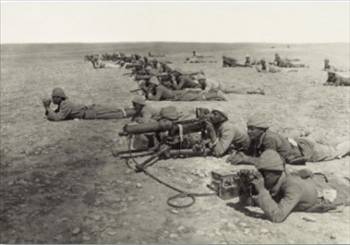Col. House in London Lends Support to Britain.
British Hold the Line at Suez.
Special to The Great War Project
(11-14 February) Colonel Edward House, the closest adviser to Woodrow Wilson, the American president, arrives in London on February 6. He sails on an American-flagged ship called the Lusitania
.
The passage is uneventful, but the date is important. One day earlier, the German admiralty announces “its intention to begin submarine warfare against Allied shipping within the waters surrounding the British Isles,” reports Arthur Link, Wilson’s biographer.
Privately, Winston Churchill, First Lord of the Admiralty, can see a benefit for the allies in this.
“Getting the United States into the war on Britain’s side was a major consideration”
…writes historian Thomas Fleming.
But this is not the moment for American entry into the conflict. House is in London for talks with the British Foreign Secretary, Sir Edward Grey, and other British leaders. Grey, too, wants the Americans to support the Allied cause. House wants to protect Wilson’s policy of neutrality. He also wants to talk about a peace settlement that Wilson has proposed.
The British are not interested, at least not until they break the stalemate on the battlefield and turn the tide to their favor.
House does not press the issue. “I could see the necessity for the Allies to try out their new armies in the spring,” House writes, “and I could also see the necessity for Germany not to be in such an advantageous position as now.” At this moment House believes Germany is less likely to agree to peace terms that would lead to “and ensure a permanent peace.”
This is a significant development, writes historian Link. No wonder the British receive it “cordially.” Foreign secretary Grey understands by this that the United States would seek peace terms that are “only acceptable to the Allies.”
However it is not clear whether Wilson agrees with the full impact of House’s pledge to the British, nor whether House is fully honest with Wilson about what he, House, has proposed to the British.
It’s a delicate and confusing moment for America’s diplomacy.
Further what is not known at this date a century ago is what the Germans mean to do with the ships of the United States and other neutral states.
As the talks between Grey and House proceed, a major battle is shaping up for one of the most strategic targets of the war – the Suez Canal. The canal is in the hands of the British, but the Turks want it. On the morning of February 4th, five-thousand Turkish troops commanded by a German officer attempt to cross the canal, according to historian Martin Gilbert.
The Turks deploy three pontoon bridges “and about sixty men succeeded in reaching the Western side of the canal,” reports Gilbert. “But they were driven off by Indian troops, supported by British warships bombarding from the sea, and the guns of an armored train.
“The Turks intend to send 20,000 troops across the canal but they fail. German plans to spark an Arab uprising against the British in Egypt are also defeated.
Two-hundred Turkish troops are killed, reports Gilbert, and some 700 taken prisoner.
The condition for prisoners of war across the global fields of battle is becoming acute.
On February 10th a century ago, reports Gilbert, 500 French soldiers are taken prisoner. “That same day 10,000 Russian troops were seized on the Eastern Front.” A few days later, another 5,000 Russians are taken prisoner.
And a few days after that “the unprecedented number of 70,000 [Russians] at Augustov” in what is now Poland.
In contrast, at the same time on the Western Front, the French capture “three yards of German trenches and four German soldiers.”


